| |
|
|
| |
Godaisan
Hill |
| |
|
 This
Prefectural Park is a major site for cherry blossoms and azaleas. From
the lookout atop the hill the whole Kochi Plain can be seen. The Kochi
Makino Public Botanical Garden and Chikurinji Temple are also to be found
here. This
Prefectural Park is a major site for cherry blossoms and azaleas. From
the lookout atop the hill the whole Kochi Plain can be seen. The Kochi
Makino Public Botanical Garden and Chikurinji Temple are also to be found
here.
Access: Take the Godaisan "Chikurinji Temple" bus from JR Kochi Station. |
| |
|
|
| |
Yokoyama Ryuichi
Comic Museum |
| |
|
Many famous cartoonists have called Kochi Prefecture
their home. One, Ryuichi Yokoyama, is a representative cartoonist
of Japan. His series “Fukuchan” appeared consecutively
in the Mainichi Newspaper 5,534 times, from 1956 to 1971, setting
a new record. He died in 2001 at the age of 92.
In this museum, Yokoyama’s works are on display, his history
told, his atelier reproduced, and some of his hobbies are exhibited.
The museum also houses representative works by contemporary cartoonists
from Kochi Prefecture, such as Kurogane Hiroshi and Hara Taira.
Open: 9:00 a.m. to 7:00 p.m.; closed every Monday and from December
28 to January 4
Location: Inside Kochi City Bunka Plaza, 2-1 Kutanda, Kochi City
Tel.: 088-883-5029 |
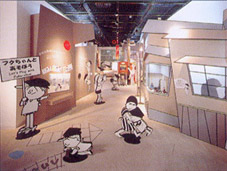 |
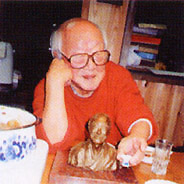 |
|
| |
|
|
| |
Young Samurai Who
Led the Way for the Meiji Restoration:
Spotlight on Sakamoto Ryoma |
| |
|
Background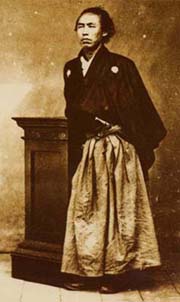
Sakamoto Ryoma was born in 1835 in Kochi City (Kochi Prefecture was previously
known as Tosa). He is viewed as having played an invaluable role in bringing
Japan into the modern world because he helped forge the alliance of the
Satsuma and Choshu clans of Kyushu, who successfully brought down the Tokugawa
shogunate, thus paving the way for the restoration of imperial rule and
the country's modernization during the Meiji Era. Sakamoto, who has gone
down in history known by his first name "Ryoma," envisioned Japan as a nation
governed by laws, a parliamentary system, and international diplomacy. Ryoma's
Japan was beset with strict feudal rules and obligations, for example,
people could not leave their home clan without getting official permission.
By the middle of the 19th century the Tokugawa bakufu was not only losing
its grip of control over various clans but some of the disgruntled daimyo
were plotting the shogunate's downfall. Having secured no permission to
leave, around 1863 Ryoma fled from Tosa and, having escaped his home clan
authorities, proceeded to become involved in the efforts for political
and economic reforms.
In Ryoma's way of thinking, the unification of Japan could be brought
about if the two strongest anti-Tokugawa clans of the time, Satsuma and
Choshu (present-day Kagoshima and Yamaguchi prefectures, respectively)
set aside their differences and formed an alliance, and in 1866 he succeeded
in bringing the two former enemies together. His "Eight Point Program"
elaborated how the country should be modernized, installing a new government
and cabinet. In 1868 the last Tokugawa ruler, Yoshinobu, surrendered,
and imperial rule was restored.
Ryoma himself was assassinated in Kyoto in November 1867 at age 33, and
thus did not live to see the full flowering of economic and political
development which occurred in the Meiji Era.
|
| |
|
Sakamoto Ryoma Memorial
Museum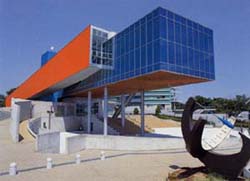
This unusual and interesting museum is located in Katsurahama, on Urado
Bay, in Kochi Prefecture, Shikoku. In 1985 - the 150th anniversary of
Sakamoto Ryoma's birth - a campaign to build a museum in honor of the
Kochi native got started and, in November 1991, the museum was opened.
The following "tour" of the museum and its holdings should whet your
appetite to go there in person. |
| |
|
| Exhibition Room 1st Floor 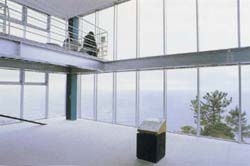
To present the life of Ryoma, the Exhibition Room is organized into
"seven stages," representing the milestones of his life, and at
each stage the ideas of the individuals who knew Ryoma are brought
to life on tape. The final stage has been named "Blank" - for visitors
to try to capture the adventurous spirit of Ryoma, the young man
who wanted to see and learn about the world, while gazing out at
the Pacific Ocean. (For quiz-lovers the museum has questions for
you on computer!)
There are changing exhibitions on the 1st floor on Sakamoto's achievements
and associates. |
| |
| Library 1st Basement Level
The library has a collection of more than 1,500 volumes on Ryoma,
the Meiji Restoration and topics from that era, freely accessible
to read or just peruse. Take the time to watch a video on the life
of Sakamoto Ryoma as well. |
| |
| Permanent Exhibition 2nd Basement Level
This exhibition includes Ryoma's correspondence, letters
from his contemporaries, as well as a replica of the bloodstained
folding screen from the inn in Kyoto wherehe was assassinated. |
| |
| Replica of a
Smith & Wesson II-32 
Takasugi Shinsaku, a leading figure in the anti-Tokugawa
revolt, gave this type of S&W pistol to Ryoma as a souvenir from
his stay in Shanghai, where he witnessed the Taiping Rebellion.
Ryoma found the weapon very useful to keep enemy samurai at bay
and in one attempt on his life at the Teradaya inn in Kyoto, possession
of the pistol saved his life. |
| |
| The Death of
Ryoma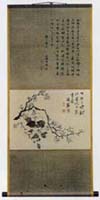 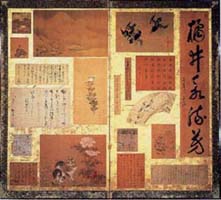
In November 1867 Ryoma and Nakaoka Shintaro, another activist, were
murdered in Kyoto by a pro-shogunate band. The screen and scroll
were in the room at the Omiya inn where they were staying.
There is a replica at the museum of the folding screen and hanging
scroll, marked with Ryoma's blood.
(Property of Kyoto National Museum) |
| |
| Reproduction of Agreement of Satsuma-Choshu
Alliance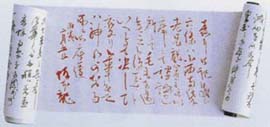
With Ryoma in attendance, representatives of the Satsuma and Choshu
domains met and agreed to form an alliance in January 1866. The
agreement's six provisions were written by Katsura Kogoro and endorsed
by Ryoma.
(Property of Imperial Household Agency) |
|
| |
|
GENERAL INFORMATION |
| Open: |
9:00 a.m. to 5:00 p.m. (Last entry at 4:30 p.m.) |
| Closed: |
December 29 to January 3. Open all other days. |
| Admission Fee: |
Adults (18 years and over) -  400 400
Groups (20 people or more, per person) -  320 320
Students (excluding university students) - Free |
| Transportation: |
Take the Kenkotsu bus (the orange one) bound for
Katsurahama and get off at Ryoma Kinenkan-mae (one stop before the
end of the line). |
|
| |
|
Katsurahama
Katsurahama beach, an attractive scenic spot, faces the vast Pacific Ocean.
It is also famous as a spectacular spot for moon-viewing. White waves
wash the seemingly endless beach dotted with evergreen pines. |
| |
|
|
| |
|
Sakamoto Ryoma
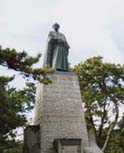 The statue
of Sakamoto Ryoma, who played an important role during the Meiji Restoration,
stands on Katsuhara beach. The statue captures Ryoma's expression as one
wistfully gazing beyond the Pacific. The statue
of Sakamoto Ryoma, who played an important role during the Meiji Restoration,
stands on Katsuhara beach. The statue captures Ryoma's expression as one
wistfully gazing beyond the Pacific. |
| |
|
A Tour Guide Service Is
Available Free of Charge
A member of the Tosa Tour Guide Volunteer Association will visit the museum
or other location with a group of tourists or even a single visitor. Please
don't hesitate to take advantage of this service. |
| |
|
| Hours: |
Between the hours of 8:00 a.m. and 5:00 p.m. |
| Place: |
Around Kochi City. Murato and Shimano are also
negotiable |
| Fee: |
Free. We ask that those who use the service cover
the transportation costs (bus and train fare) of the volunteer guide. |
| Inquiries and Application: |
Katsurahama Tourist Information
9, Urado, Kochi City, Kochi Prefecture
(TEL/FAX: 088-842-0081)
Closed December 29 to January 3. Open all other days. |
|
| |
|
|
| |
Kochi
Castle |
| |
|
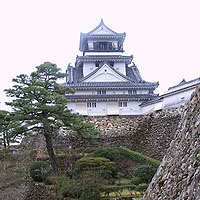 The
classic Castle is located in the center of Kochi and has been designated
an Important Cultural Asset by the national government. The castle was
built by Yamanouchi Kazutoyo who was awarded the 240,000 koku (unit of
rice) domain, and has since been the most well-known of castles on the
Nankaido for some 400 years. The stairway leading up to the castle is
purposely hard to climb with the stone steps of differing widths and heights
in order to thwart off enemies. Construction of the castle began in 1601,
making this its 400th year, and Kochi has planned the "400th Anniversary
Festival of the Founding of Kochi Castle" with a number of events to be
held throughout the year. The
classic Castle is located in the center of Kochi and has been designated
an Important Cultural Asset by the national government. The castle was
built by Yamanouchi Kazutoyo who was awarded the 240,000 koku (unit of
rice) domain, and has since been the most well-known of castles on the
Nankaido for some 400 years. The stairway leading up to the castle is
purposely hard to climb with the stone steps of differing widths and heights
in order to thwart off enemies. Construction of the castle began in 1601,
making this its 400th year, and Kochi has planned the "400th Anniversary
Festival of the Founding of Kochi Castle" with a number of events to be
held throughout the year.
Kochi Castle Management Office Tel: 088-824-5701
Hours 9:00 a.m. - 4:30 p.m.
Closed December 26 - January 1
Access A five-minute walk from Kochi-jo Mae on the street car, 10 minutes
from JR Kochi Station. |
| |
|
|
| |
Chikurinji
Temple |
| |
|
.
| Set in the mountain, this 31st stop on the 88 temple pilgrimage
of Shikoku is known as a temple of knowledge. The temple was erected
in 724 by priest Gyoki. It is not uncommon to see worshippers clad
in white who are making the pilgrimage. Also located on the temple
grounds are traditional gardens, one of the three famous gardens of
Kochi Prefecture. The north garden is typical of those of the southern
states, while the west garden which offers a serene refinement |
 |
 |
 |
|
| |
|
|
| |
Kochi
Makino Public Botanical Garden |
| |
|
        |
| |
|
World-reknowned botanist Dr. Makino Tomitaro is the namesake
for this botanical garden. The garden is home to some 1500 plant species
that thrive throughout the four seasons, with a focus on those native
to Kochi Prefecture. Also located in the garden is The Makino Museum of
Plants and People opened in 1999 in memory of Dr. Makino. The peculiar
wooden construction of this building lends itself beautifully to the surrounding
natural environment.
Kochi Makino Public Botanical Garden Tel: 088-882-2601
Homepage http://www.i-kochi.or.jp/hp/makino
Hours 9:00 a.m. - 5:00 p.m. Closed Mondays and December 27 - January 1
Admission  500 (High school
students and younger free) 500 (High school
students and younger free) |
| |
|
|
| |
|
|
| |
Sunday
Market |
| |
|
Some 600 stalls stretch over a one-kilometer area
from Oitemon, the main gate of Kochi Castle in the Sunday Market.
Wares include fruits and vegetables, seafood, plants, daily wares,
antiques and much more boasting "if its not here, it doesn't exist".
The Sunday Market has been going on since 1690, more than three
hundred years, and some 40,000 people are said to visit the market
per day, making it the biggest, and oldest, in all of Japan.
April - September: 5:00 a.m. - 6:00 p.m.
October - March: 6:00 a.m. - 5:00 p.m. |
 |
 |
|










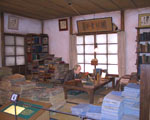
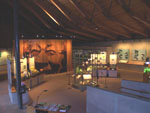


 This
Prefectural Park is a major site for cherry blossoms and azaleas. From
the lookout atop the hill the whole Kochi Plain can be seen. The Kochi
Makino Public Botanical Garden and Chikurinji Temple are also to be found
here.
This
Prefectural Park is a major site for cherry blossoms and azaleas. From
the lookout atop the hill the whole Kochi Plain can be seen. The Kochi
Makino Public Botanical Garden and Chikurinji Temple are also to be found
here.







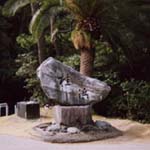
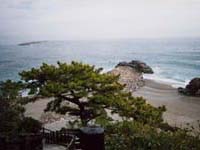
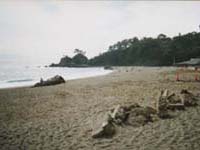
 The statue
of Sakamoto Ryoma, who played an important role during the Meiji Restoration,
stands on Katsuhara beach. The statue captures Ryoma's expression as one
wistfully gazing beyond the Pacific.
The statue
of Sakamoto Ryoma, who played an important role during the Meiji Restoration,
stands on Katsuhara beach. The statue captures Ryoma's expression as one
wistfully gazing beyond the Pacific.  The
classic Castle is located in the center of Kochi and has been designated
an Important Cultural Asset by the national government. The castle was
built by Yamanouchi Kazutoyo who was awarded the 240,000 koku (unit of
rice) domain, and has since been the most well-known of castles on the
Nankaido for some 400 years. The stairway leading up to the castle is
purposely hard to climb with the stone steps of differing widths and heights
in order to thwart off enemies. Construction of the castle began in 1601,
making this its 400th year, and Kochi has planned the "400th Anniversary
Festival of the Founding of Kochi Castle" with a number of events to be
held throughout the year.
The
classic Castle is located in the center of Kochi and has been designated
an Important Cultural Asset by the national government. The castle was
built by Yamanouchi Kazutoyo who was awarded the 240,000 koku (unit of
rice) domain, and has since been the most well-known of castles on the
Nankaido for some 400 years. The stairway leading up to the castle is
purposely hard to climb with the stone steps of differing widths and heights
in order to thwart off enemies. Construction of the castle began in 1601,
making this its 400th year, and Kochi has planned the "400th Anniversary
Festival of the Founding of Kochi Castle" with a number of events to be
held throughout the year. 



